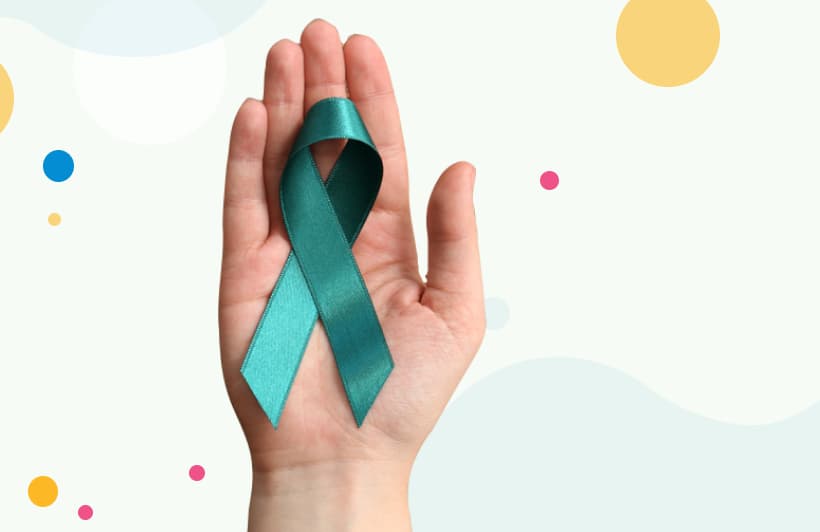
25 Jan, 2022

25 Jan, 2022
Breast cancer and ovarian cancer are the two common cancers occurring in females. One in every eight females, or around 12 %, may get breast cancer in their lifespan. Ovarian cancer is just less prevalent, with an incidence rate of about 2% for the overall population.
Many mutations in growth control genes can cause tumours to grow in the body. Some of the reasons for cancer are still unknown. Researchers have been exploring the relationship between breast and ovarian cancer in recent years to discover the previously unknown connection between both cancers.
In a nutshell, knowing the associations between breast and ovarian cancers encourages the prevention of metastases and the establishment of novel cancer treatments.
Your risk of breast cancer increases due to a mutation in particular genes, BRCA1 and BRCA2, which may run in family.
Breast cancer risk is around 12% in the general population but can range between 46 and 87 per cent for women with a BRCA1 gene variant. The risk is about 38 to 84 per cent for those with a BRCA2 variant.
Genetic testing can help in finding these genetic mutations. Additionally, there are unidentified genes that certainly contribute to hereditary breast cancers.
The ovarian cancer risk in women with a BRCA1 or BRCA2 mutation following an initial breast cancer diagnosis and identifying host and treatment-related variables might alter the risk. In addition, alterations in genetic makeup in the family may cause some ovarian cancers. BRCA1 and BRCA2 are two genes that make it more likely to get ovarian cancer. The risk of ovarian cancer is around 2% in the general population, but approximately 39% to 63% with BRCA1 gene variants and 16.5% to 27% with BRCA2 gene variations. These genes also make it more likely to get breast cancer.
Gene changes linked to Lynch syndrome and the genes BRIP1, RAD51C and RAD51D raise the risk of ovarian cancer.
Genetic risk for breast and ovarian cancer is highest when pathogenic (dangerous) mutations in the BRCA1 and BRCA2 (BRCA1/2) genes. Pathogenic mutations in these genes account for around 6 per cent of breast cancer cases and 20 per cent of all ovarian cancer cases.
In breast and ovarian epithelial cells, the expression of BRCA1 and BRCA2 genes occurs. They regulate the repairing of specific categories of DNA damage. Therefore, if there are any mutations or damage to BRCA1 or BRCA2, it cannot repair DNA damage properly, resulting in an increased risk of breast cancer.
According to preliminary data, 60-80% of BRCA1/BRCA2 gene mutation carriers will acquire breast cancer, whereas 20-40% will have ovarian cancer. Other high-to-moderate-risk genes, such as tumour protein p53 (TP53), partner and localiser of BRCA2 (PALB2), phosphatase and tensin homolog (PTEN), checkpoint kinase 2 (CHEK2), ataxia-telangiectasia mutant (ATM) and serine/threonine kinase 11 (STK11), account for a lesser proportion of breast and, in certain circumstances, ovarian cancers.
Administration of hormone replacement therapy to treat menopause symptoms increases the risk of developing ovarian cancer. There is, however, a decrease in the risk when treatment is no longer taking place.
Estrogen, progesterone and androgen hormones control the onset of carcinogenesis by interacting with special hormone receptors in the body. In addition, hormonal therapies are often used to treat hormone-related diseases, such as cancer. Several candidate genes have been found as a biomarker for ovarian and breast cancers.
Women exposed to estrogen, whether it is synthesised inside the body or from outside sources, have an enhanced risk of developing breast or ovarian cancer. Expression levels of the genes BRCA1 and BRCA2 are at their highest during pregnancy and puberty when estrogen levels are high.
Understanding the risk of cancer associated with mutations in the BRCA1 and BRCA2 genes is crucial for affected individuals and their medical team to make the best health decisions possible. Cancer care institutes strongly recommend getting genetic counselling from well-trained people, like genetic counsellors, to help people with cancer.
After counselling regarding the individual cancer risk, surgical intervention (mastectomy) may be advised. Doctors predict that prophylactic mastectomy reduces cancer risk in unaffected women by 90-95 per cent.
Chemoprevention is another therapy option. Chemoprevention is a term that refers to the use of certain medications to reduce the chance of getting breast cancer.
Between 2017 and 2018, the United States Food and Drug Administration approved several drugs to treat BRCA-associated breast and ovarian cancer. For more information on the FDA-approved chemoprevention medications, please talk to a cancer specialist.
The therapeutic management of cancer may require a multidisciplinary team of medical professionals. It includes physicians who specialise in diagnosing and treating cancer (medical oncologists), physicians who specialise in radiation to treat cancer (radiation oncologists), oncology nurses, psychiatrists and other healthcare specialists. Additionally, family psychosocial support is crucial too.
Even though more people are studying breast and ovarian cancer, these are the most common causes of death among women. Identifying differences will help scientists find connections between breast and ovarian cancer. In addition, it will lead to new approaches to screen the disease and help them understand how these two cancers spread.
For any enquiries related to breast cancer treatment at HCG, please reach out to us on +919513165955 or registerhere